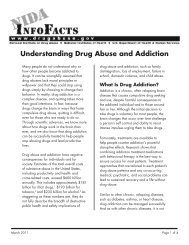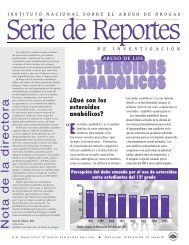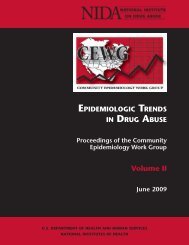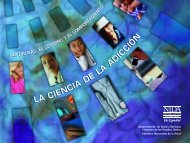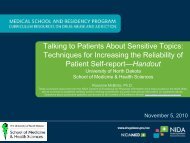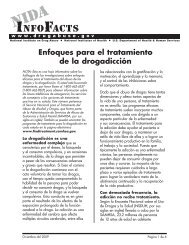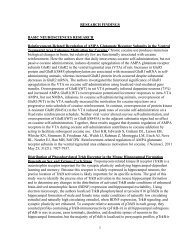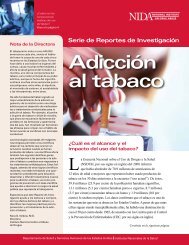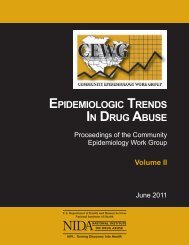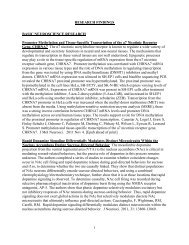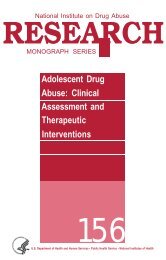CEWG January 09 Full Report - National Institute on Drug Abuse
CEWG January 09 Full Report - National Institute on Drug Abuse
CEWG January 09 Full Report - National Institute on Drug Abuse
Create successful ePaper yourself
Turn your PDF publications into a flip-book with our unique Google optimized e-Paper software.
EpidEmiologic TrEnds in drug AbusE: HigHligHTs And ExEcuTivE summAry<br />
reflect an aging populati<strong>on</strong> based <strong>on</strong> methamphetamine<br />
ED reports, with 28 percent over age<br />
45. Marijuana treatment admissi<strong>on</strong>s were up by<br />
15 percent between fiscal years (FYs) 2007 and<br />
2008. There were significant recent increases in<br />
the proporti<strong>on</strong>s of hydrocod<strong>on</strong>e and oxycod<strong>on</strong>e<br />
am<strong>on</strong>g unweighted ED reports in the coastal<br />
counties but not the inland counties. Phencyclidine<br />
(PCP), gamma hydroxybutyrate (GHB),<br />
lysergic acid diethylamide (LSD), and ketamine<br />
indicators were minimal. HIV/AIDS Update:<br />
Acquired immunodeficiency syndrome (AIDS)<br />
annual caseload increase is at 2.3 percent am<strong>on</strong>g<br />
both heterosexual and gay/bisexual male injecti<strong>on</strong><br />
drug users over the past reporting period.<br />
Data Sources: Treatment admissi<strong>on</strong>s data<br />
were available for all five bay area counties for FYs<br />
2007 and 2008. These data were compiled by the<br />
California Department of Alcohol and <strong>Drug</strong> Programs.<br />
Unweighted ED <strong>Drug</strong> <strong>Abuse</strong> Warning Network<br />
(DAWN) Live! data from Offce of Applied<br />
Studies, Substance <strong>Abuse</strong> and Mental Health Services<br />
Administrati<strong>on</strong> were available to report drug<br />
menti<strong>on</strong>s in ED visits for 2008, although data for<br />
the last few m<strong>on</strong>ths of the year were incomplete.<br />
<str<strong>on</strong>g>Report</str<strong>on</strong>g>s of arrests for drug law violati<strong>on</strong>s were<br />
provided by the San Francisco Police Department<br />
for 2001–2006. Price and purity data came from<br />
the <strong>Drug</strong> Enforcement Administrati<strong>on</strong>, HDMP, and<br />
referenced heroin “buys” mostly made in San Francisco<br />
County. Data for 2007 were compared with<br />
those for 2001–2006. Data <strong>on</strong> traffcking in heroin<br />
and other drugs were available from the <str<strong>on</strong>g>Nati<strong>on</strong>al</str<strong>on</strong>g><br />
<strong>Drug</strong> Intelligence Center and pertained to wholesale,<br />
midlevel, and retail prices prevailing in San<br />
Francisco in early 2007. AIDS surveillance data<br />
were provided by the San Francisco Department of<br />
Public Health and covered the period through September<br />
30, 2008.<br />
<strong>Drug</strong> <strong>Abuse</strong> Patterns and Trends in the<br />
Seattle/King County Area—Update:<br />
<str<strong>on</strong>g>January</str<strong>on</strong>g> 20<str<strong>on</strong>g>09</str<strong>on</strong>g><br />
Caleb Banta-Green, T. R<strong>on</strong> Jacks<strong>on</strong>, Steve<br />
Freng, Michael Hanrahan, Mary Taylor,<br />
John Ohta, Glenn Baldwin, David H. Albert,<br />
Richard Harruff, and Geoff Miller<br />
For inquiries c<strong>on</strong>cerning this report, please c<strong>on</strong>tact<br />
Caleb Banta-Green, M.P.H., M.S.W., Ph.D.,<br />
Research Scientist, Alcohol and <strong>Drug</strong> <strong>Abuse</strong> <str<strong>on</strong>g>Institute</str<strong>on</strong>g>,<br />
University of Washingt<strong>on</strong>, 1107 NE 45th St,<br />
Suite 120; Seattle, WA 98105, Ph<strong>on</strong>e: 206–685–<br />
3919, Fax: 206–543–5473, E-mail: calebbg@u.<br />
washingt<strong>on</strong>.edu, Web: http://adai.washingt<strong>on</strong>.edu<br />
or R<strong>on</strong> Jacks<strong>on</strong>, M.S.W., Evergreen Treatment Services,<br />
Ph<strong>on</strong>e: 206–223–3644, E-mail: r<strong>on</strong>jack@u.<br />
washingt<strong>on</strong>.edu.<br />
Overview of Findings: No major changes<br />
were evident in data available for the Seattle/<br />
King County area for the first half of 2008, compared<br />
with prior years, with small numbers and<br />
the short time frame precluding trend analyses.<br />
<strong>Drug</strong>s with substantial negative impacts <strong>on</strong><br />
health and mortality included prescripti<strong>on</strong>-type<br />
opiates, cocaine, and heroin. Methamphetamine<br />
indicators have generally leveled off or declined<br />
slightly. Marijuana indoor growing operati<strong>on</strong>s<br />
are substantial in the Seattle area, and use is comm<strong>on</strong>.<br />
Alcohol and benzodiazepines c<strong>on</strong>tinued<br />
to be frequently used in combinati<strong>on</strong> with other<br />
drugs, both am<strong>on</strong>g those entering treatment and<br />
am<strong>on</strong>g those dying from drug overdoses. MDMA<br />
is being manufactured in substantial quantities in<br />
the adjacent Canadian province of British Columbia<br />
and shipped through Washingt<strong>on</strong>. MDMA<br />
use appeared to c<strong>on</strong>tinue at moderate levels<br />
am<strong>on</strong>g young adults in the area. BZP (1-benzylpiperazine)<br />
is has emerged as an MDMA-like drug,<br />
often sold as MDMA. There is persistent heroin<br />
use, mostly in the Seattle area, with increasing<br />
prescripti<strong>on</strong> opiate use widespread throughout<br />
King County. Mortality for heroin is at its lowest<br />
point in at least a decade, while prescripti<strong>on</strong>-type<br />
opiates remained the drugs most comm<strong>on</strong>ly identified<br />
in fatal overdoses.<br />
Updated <strong>Drug</strong> <strong>Abuse</strong> Trends and Emerging<br />
Patterns: Cocaine was the most comm<strong>on</strong> illicit<br />
drug identified in unweighted emergency department<br />
(ED) reports, with 2,132 reports, double<br />
64<br />
Proceedings of the Community Epidemiology Work Group, <str<strong>on</strong>g>January</str<strong>on</strong>g> 20<str<strong>on</strong>g>09</str<strong>on</strong>g>



